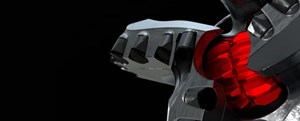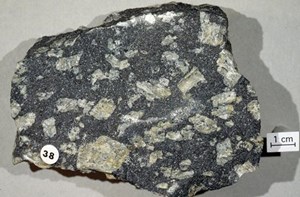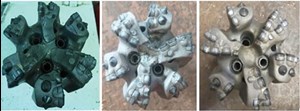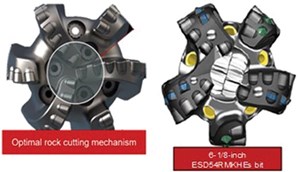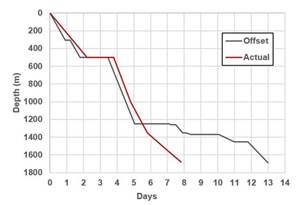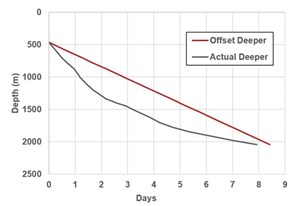In the Parnaiba basin, in northeastern Brazil, hard rock pushes the limits of existing drill bit technology. Having very low tolerance for sub-optimal drilling performance, the operator is continuously seeking new technologies in a quest to reduce well times.
Therefore, the Halliburton Design at the Customer Interface (DatCISM) process was challenged by the operator to provide an innovative solution to reduce the number of bit runs in the reservoir section of its Monobore wells, where there were frequent unplanned trips related to bit wear after drilling through very hard diabase intercalations of approximately 45 kpsi unconfined compressive strength (UCS).
For this difficult reservoir section, the Halliburton Drill Bits and Services team recommended its new Crush & Shear™ drill bit technology. This hybrid concept is designed to be compatible with hard formation challenges, as it increases efficiency and durability via a crushing and shearing rock-cutting mechanism in the inner bit area.
For a field trial in this basin, the service company’s Drill Bits and Services team developed the new 61/8–in. ESD54RMKHEs bit. In its first well, this bit managed to improve the block’s average rate of penetration (ROP), and, in the second test, it set a record by reaching total depth (TD) in a single run, improving ROP by 30% against similar offset wells.
And following the above field trial, the stage was set to test the technology for the case it was originally designed for: to drill the deeper diabase rocks found throughout the formations underlying the main reservoir zones. In the first well of a new campaign, the 61/8–in. Crush & Shear drill bit accomplished a feat never seen before in the Parnaiba basin—a mud motor-driven, record-breaking run in excess of 1,576 m, with several diabase rock intervals (> 170 m thick, >330 m total). It set a new benchmark for performance and durability in the basin, Table 1.
CHALLENGES
Located close to the Amazonian jungle in northeastern Brazil, the Parnaiba basin comprises a sequence of shale and sandstone with thick layers of diabase, an igneous rock (Fig. 1) with unconfined compressive strengths (UCS) going beyond 45 kpsi. This rock type is widely known in North Brazil as the toughest formation to drill through, and its presence has been a constant challenge for the operator, due to potential bit wear while drilling with mud motors.
This challenging diabase can be considered equivalent to volcanic basalt or plutonic gabbro. It is present in the Parnaiba basin, due to geological discontinuities, such as fractures, changes of facies, or faults, which allow it to intrude into the sedimentary rocks that normally comprise the area lithology column. This effect causes the irregular appearance of diabase across the basin, with several layers of a few meters of this rock in some wells and much longer intervals in others.
Regardless of the length we can find in a well, the layers of diabase are present in any of these two typical shapes, a symmetrical staggered or asymmetric staggered, a phenomenon produced by the system of fractures and faults with small or large tailings respectively. In both cases, diabase is a highly compressive rock, needing a significant amount of energy to fail it.
During a previous drilling campaign, it was observed that all wells deeper than 2,000 m had diabase sections around 150 m, and that the best offset well required at least two bits to achieve the planned TD. The majority of trips pulled cored or ringed-out bits with no wells drilled in a single run.
A dedicated analysis showed a typical well in the area had these conditions: A) required at least three bit runs to reach total depth (TD); B) an inconsistent bit response in the hard diabase interval, in which the typical motor’s revolutions per minute (RPMs) adversely accelerated the cutter’s nose / shoulder wear; and C) other drilling parameters, such as weight on bit (WOB), produced a cone / nose over-engagement that destroyed diamond cutters in that area in just a few meters. Most of the bits in this application were able to drill smoothly in the shale and sandstone sequences, with rates of penetration varying, depending on their design features.
In all cases, there was a common performance marker, once the bit entered into the hard diabase; a poor ROP accompanied by cutter breakage; and, in most cases, compromising the bit body at levels, depending on how much energy and for how long the bit was drilling into diabase. All the traditional six-bladed and seven-bladed polycrystalline diamond compact (PDC) bits came out in very bad condition, suggesting the need for heavier-set designs, in order to protect the tool’s cutting structure when drilling through hard formations. There was a wide range of six and seven- bladed PDC bits tested (Fig. 2) under the described conditions, combining different grades of diamond and modifying cutter’s layout to improve bit durability, however results were not favorable leading to concepts of higher blade count. Increasing the diamond volume would negatively affect the bit’s performance in shales and could also cause additional issues, such as bit balling. Therefore, a different solution was required.
SOLUTION
The Crush & Shear™ bit (Fig. 3) was identified as the appropriate technology for this application, as it combines the efficiency of traditional PDC cutters with the torque-reducing capabilities of rolling elements, to increase drilling efficiency and maximize bit stability through hard, interbedded formations. It can withstand high WOB while also reducing torque fluctuations, which results in improved tool face control and smoother drilling. Its lateral stability reduces overall vibrations, increases drilling efficiency, and extends the life of the PDC elements.
In the design process for this new drill bit, implementing the crushing rock mechanism on slim sizes brought additional challenges, due to the limited available space on the bit body. Replacing the fixed cone cutting structure of a 61/8–in. bit required innovation over traditional alternatives. The preliminary analysis led to higher blade count concepts, with potential eight- blade prototypes, which may assure better durability at much lower performance, a solution that went against the application objective.
The rolling elements and the crushing rock mechanism offered an additional resistance to undesired high torque variations in the inner cutting structure. This is a benefit that allowed changing of the design path to follow a different direction toward lower blade frames into a final Crush & Shear five-blade design incorporating additional cutting elements.
RESULTS
The Crush & Shear™ bit was run in the last two wells of the 2020 drilling campaign, setting basin-wide records. In the first well, which was a vertical application, the Crush & Shear bit demonstrated its potential by exceeding all offset well ROPs. It delivered 20% more overall ROP, drilling twice as fast as other bits in the hard diabase interval. The on-the-fly modification of well schematics changed the well from vertical into directional, leading into a trip to adjust the bottomhole assembly components. Bit dull was 2-1-LT-X-I-BT-BHA.
For the second well, there was the additional challenge of building angle (offsets for a well targeting the main reservoir suggest more than two bits). The Crush & Shear was the first bit in, having drilled the challenging 61/8–in production section to TD in a single run. Its durability in the hard formations was key to improving the total drilling time of the reservoir section by 25% and reducing the overall spud-to-TD time from 9.45 days to 7.8 days (Fig. 4), thus achieving significant savings for the operator.
The operator then decided to adopt the use of the technology for a new campaign, where there was a bigger scope for deep exploratory wells with longer diabase intervals (up to twice more diabase meterage than previous wells), Fig. 5. In the first well, the Crush & Shear bit set a new benchmark for performance and durability, drilling 1,576 m in a single run, surpassing the meterage of the offset well by 44%. In total, 335 m of hard diabase rock were drilled, which translated into 49% more meterage by a single bit through this kind of lithology and a rig time reduction of 0.6 days against previous wells.
The Crush & Shear hybrid bit has become a promising technology to tackle hard rock drilling in the Parnaiba basin, with the potential to bring further substantial savings. The operator is primed to drill deeper, more challenging wells with confidence, leveraging the use of this innovative solution.

- Coiled tubing drilling’s role in the energy transition (March 2024)
- Digital tool kit enhances real-time decision-making to improve drilling efficiency and performance (February 2024)
- E&P outside the U.S. maintains a disciplined pace (February 2024)
- U.S. operators reduce activity as crude prices plunge (February 2024)
- Drilling advances (January 2024)
- Driving MPD adoption with performance-enhancing technologies (January 2024)

